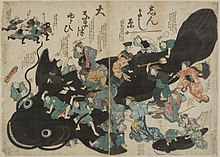
The University of Tokyo is a public research university in Bunkyō, Tokyo, Japan. Founded in 1877 as the nation's first modern university by the merger of several pre-westernisation era institutions, its direct precursors include the Tenmongata, founded in 1684, and the Shoheizaka Institute.
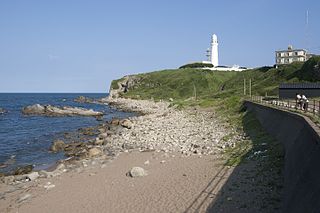
Chiba Prefecture is a prefecture of Japan located in the Kantō region of Honshu. Chiba Prefecture has a population of 6,278,060 and has a geographic area of 5,157 km2 (1,991 sq mi). Chiba Prefecture borders Ibaraki Prefecture to the north, Saitama Prefecture to the northwest, and Tokyo to the west.

Lieutenant-General Mori Rintarō, known by his pen name Mori Ōgai, was a Japanese Army Surgeon general officer, translator, novelist, poet and father of famed author Mari Mori. He obtained his medical license at a very young age and introduced translated German language literary works to the Japanese public. Mori Ōgai also was considered the first to successfully express the art of western poetry in Japanese. He wrote many works and created many writing styles. The Wild Geese (1911–1913) is considered his major work. After his death, he was considered one of the leading writers who modernized Japanese literature.
A discovery system is a bibliographic search system based on search engine technology. It is part of the concept of Library 2.0 and is intended to supplement or even replace the existing OPAC catalogs. These systems emerged in the late 2000s in response to user desire for a more convenient search option similar to that of internet search engine. The results from searching a discovery system may include books and other print materials from the library's catalog, electronic resources such as e-journals or videos, and items stored in other libraries.

The National Diet Library (NDL) is the national library of Japan and among the largest libraries in the world. It was established in 1948 for the purpose of assisting members of the National Diet of Japan in researching matters of public policy. The library is similar in purpose and scope to the United States Library of Congress.
Landsbókasafn Íslands – Háskólabókasafn is the national library of Iceland which also functions as the university library of the University of Iceland. The library was established on December 1, 1994, in Reykjavík, Iceland, with the merger of the former national library, Landsbókasafn Íslands, and the university library. It is the largest library in Iceland with about one million items in various collections. The library's largest collection is the national collection containing almost all written works published in Iceland and items related to Iceland published elsewhere. The library is the main legal deposit library in Iceland. The library also has a large manuscript collection with mostly early modern and modern manuscripts, and a collection of published Icelandic music and other audio. The library houses the largest academic collection in Iceland, most of which can be borrowed for off-site use by holders of library cards. University students get library cards for free, but anyone can acquire a card for a small fee. The library is open for public access.
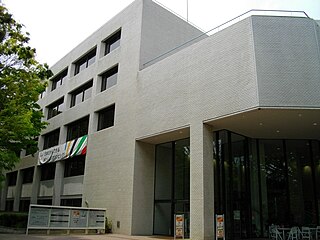
Tokyo Metropolitan Library is the metropolitan public library system for Tokyo, Japan.
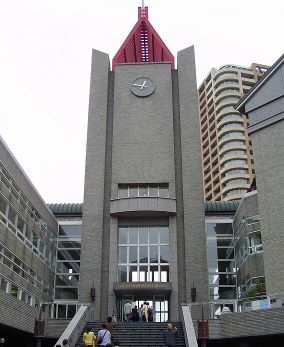
The collections of Waseda University Library form one of the largest libraries in Japan. Established in 1882, they currently hold some 5.6 million volumes and 46,000 serials.

The Historiographical Institute of the University of Tokyo is a research institution affiliated with the University of Tokyo that is devoted to the analysis, compilation, and publication of historical source materials concerning Japan. Since its foundation in 1869, the Institute has been a major center of Japanese historical research, and makes historical sources available through its library, publications, and databases.

A digital library is an online database of digital objects that can include text, still images, audio, video, digital documents, or other digital media formats or a library accessible through the internet. Objects can consist of digitized content like print or photographs, as well as originally produced digital content like word processor files or social media posts. In addition to storing content, digital libraries provide means for organizing, searching, and retrieving the content contained in the collection. Digital libraries can vary immensely in size and scope, and can be maintained by individuals or organizations. The digital content may be stored locally, or accessed remotely via computer networks. These information retrieval systems are able to exchange information with each other through interoperability and sustainability.

The Central Philippine University Library is the library system of the Central Philippine University in Iloilo City, Philippines. Established in 1910, it is one of the largest academic and research libraries in the Philippines at present with more than 250,000 volumes or holdings it has, including special collections categorized into sections which include the 40,000+ United Nations Documents, American Studies Resource Center, Meyer-Asian Collection, Food and Agriculture Organization and Elizabeth Knox Sacred Music Collection. Rare collections of Second World War documents and Asian archaeological artifacts are also found in the collection of the main library.

Tenri Central Library is the library of Tenri University. It has notably extensive collections of antiquarian material, including original manuscripts from 13th-century Japan, and artifacts of European exploration and early visits to Japan. Dating to 1926, the library predates the university itself. It has its origins in the private collection of the family of the foundress of Tenrikyo, Oyasama.

The University Library Svetozar Marković(Serbian: Универзитетска библиотека Светозар Марковић) is the main library in the University of Belgrade system, named after Svetozar Marković, a Serbian political activist in the 19th century. It is located on King Alexander Boulevard, close to the Faculty of Law and adjacent to the Faculties of Civil Engineering, Electrical Engineering, and Architecture. Serves the educational and scientific needs of students, academics, and scientists. Library Day is 24 May, a day commemorating Slavic educators St. Cyril and Methodius. At the founding of the library, the collection contained 57,254 publications consisting of monographs and serials. Today, the library contains roughly 1,700,000 publications.
Tokyo Institute of Technology Library is the largest science and technology library in Japan. It was founded in 1882 as part of the Tokyo Vocational School, and at the time had nearly 4700 books. In the following year, expansion legislation was passed on its behalf, and it grew to over 457,000 m2 by 1902.
Watanabe Katei was a Japanese writer who wrote many popular novels under the pen names Hekirurien, Kuroboshi, Ryokuensho, among others. His extensive collection of Japanese fiction from the Edo period is now housed at University of Tokyo Library.
The Hongō campus (本郷キャンパス) is the main campus of the University of Tokyo. While some interdisciplinary and advanced research takes place at Komaba or Kashiwa, most faculties and institutes are located at Hongō. Most undergraduates in the senior division and postgraduates study on the campus.

The Ishikawa Takeyoshi Memorial Library is a private library in Chiyoda, Tokyo, Japan. The library first opened in December 1947 as the Ochanomizu Library (お茶の水図書館), for the exclusive use of women; men have been admitted since its reorganization in October 2003. The library is named after Ishikawa Takeyoshi (1887–1961), founder of Japanese publishing house Shufunotomo, who, in 1941, established the predecessor of today's Ishikawa Takeyoshi Memorial Library General Foundation, the change in name and legal form occurring in 2013.
The Kashiwa Campus, University of Tokyo is one of the three main campuses of the University of Tokyo located in Kashiwa, Chiba. It is also referred to as the "Kashiwa Campus" or simply "Kashiwa District". It consists of three subareas divided by parks and roads: Kashiwa, Kashiwa II, and Kashiwanoha Station Front.

The College of Arts and Sciences is one of the ten undergraduate faculties of the University of Tokyo and the only one referred to as a college. The Graduate School of Arts and Sciences is the postgraduate and research school attached to it. Originally, the college was a university preparatory boarding school called the First Higher School until 1950, and it still operates on the Komaba Campus, which used to belong to the higher school and is separate from the rest of the university. Hence, the word Komaba is synonymous with the College of Arts and Sciences within the university.

 Interior of the General Library
Interior of the General Library One of the reading rooms
One of the reading rooms another reading room
another reading room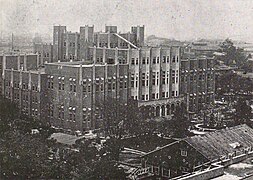 General Library in 1931
General Library in 1931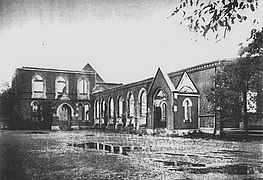 General Library after the Great Earthquake in 1923
General Library after the Great Earthquake in 1923 A deer head, a gift from King George V in 1911
A deer head, a gift from King George V in 1911






